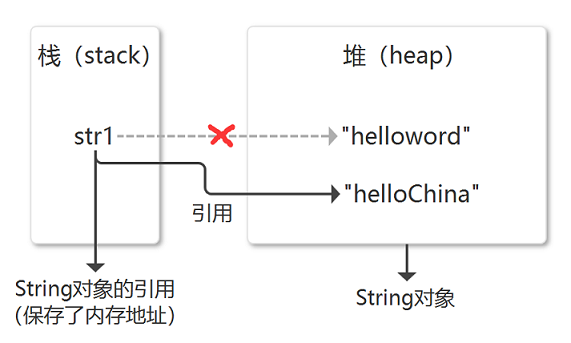J2SE入门(三) String、StringBuffer、StringBuilder
String可以说是Java中使用最多最频繁的类,也是面试中会经常被问到的知识点。
一. String的使用
1. String的不可变性
/**
* The {@code String} class represents character strings. All
* string literals in Java programs, such as {@code "abc"}, are
* implemented as instances of this class.
* <p>
* Strings are constant; their values cannot be changed after they
* are created. String buffers support mutable strings.
* Because String objects are immutable they can be shared. For example:
* ...
*/
public final class String {
private final char value[];
}String对象一旦在堆中创建出来,就无法再修改。因为String对象放在char数组中,该数组由final关键字修饰,不可变。
2. 定义一个字符串
/**
* 定义一个字符串
*/
String str1 = "helloworld";
//也可以,但基本不这样写
String str2 = new String("helloworld");上面的这句代码在内存中怎么体现?

3. 再次赋值给已定义的字符串
str1 = "helloChina";我们开始已经说了String是由final关键字修饰,不可变,那么此时在内存中如何体现呢?

4. 使用变量来赋值变量
String str3 = str1;这个时候str3和str1引用了相同的对象“helloChina”

5. String 对 “+” 的处理
String str4 = "good good" + " study";通过编译工具后得到
String str4 = "good good study";因此我们可以发现编译器在编译期间就是进行变量合并,而不会在内存中创建三个对象 “good good”,“ study”,"good good study"。但若是:
String str5 = str3 + "good good study";这种情况无法在编译期间就进行变量合并。
6. String常用的方法
//str1 == "hello,world ";
//获取长度
str1.length()//12;
//截取位置2到5之间的字符串(包括位置2,不包括位置5,从0开始)
str1.substring(2,5);//"llo"
//判断是否含有字符串“ello”
str1.contains("ello");//true,通过indexOf实现
//获取ello在str1中的开始位置
str1.indexOf("ello");//1
//将字符串转化为字符串数据
str1.split(",");//["hello","world"]
//去掉字符串两侧空格
str1.trim();//"hello,world"二. StringBuffer与StringBuilder
StringBuilder与StringBuffer作用就是用来处理字符串,但String类本身也具备很多方法可以用来处理字符串,那么为什么还要引入这两个类呢?看下面的例子
public static void main(String[] args) {
String str0 = "hel,lo,wor,l,d";
long start = System.currentTimeMillis();
for (int i = 0; i < 100000; i++){
str0 += i;
}
System.out.println(System.currentTimeMillis() - start);
StringBuilder sb = new StringBuilder("hel,lo,wor,l,d");
long start1 = System.currentTimeMillis();
for (int i = 0; i < 100000; i++){
sb.append(i);
}
System.out.println(System.currentTimeMillis() - start1);
StringBuffer sbf = new StringBuffer("hel,lo,wor,l,d");
long start2 = System.currentTimeMillis();
for (int i = 0; i < 100000; i++){
sbf.append(i);
}
System.out.println(System.currentTimeMillis() - start2);
}上述代码中3处循环完成了同样的功能,字符串拼接,执行的结果如下:
36823
3
4可以看出执行时间差别太大,为了解决String不擅长的大量字符串拼接这种业务场景,引入了StringBuffer和StringBuilder.
| String | StringBuffer | StringBuilder |
|---|---|---|
| final修饰,不可继承 | final修饰,不可继承 | final修饰,不可继承 |
| 字符串常量,创建后不可变 | 字符串变量,可动态修改 | 字符串变量,可动态修改 |
| 不存在线程安全问题 | 线程安全,所有public方法由synchronized修改 | 线程不安全 |
| 大量字符串拼接效率最低 | 大量字符串拼接效率非常高 | 大量字符串拼接效率最高 |
StringBuffer与StringBuilder实现非常类似,下面以StringBuilder简单说明一下append()方法基本原理
1. 首先创建一个StringBuilder
StringBuilder sb1 = new StringBuilder();
StringBuilder sb2 = new StringBuilder(100);StringBuilder对字符串的操作是通过char[]来实现的,通过默认构造器创建的StringBuilder,其内部创建的char[]的默认长度为16,当然可以调用重载的构造器传递初始长度(推荐这样,因为这样可以减少数组扩容次数,提高效率)。
/**
* Constructs a string builder with no characters in it and an
* initial capacity of 16 characters.
*/
public StringBuilder() {
super(16);
}2. StringBuilder的append()方法
每次调用append(str)方法时,会首先判断数组长度是否足以添加传递来的字符串
/**
* Appends the specified string to this character sequence.
* <p>
* The characters of the {@code String} argument are appended, in
* order, increasing the length of this sequence by the length of the
* argument. If {@code str} is {@code null}, then the four
* characters {@code "null"} are appended.
*
* @param str a string.
* @return a reference to this object.
*/
public AbstractStringBuilder append(String str) {
if (str == null)
return appendNull();
int len = str.length();
ensureCapacityInternal(count + len);
str.getChars(0, len, value, count);
count += len;
return this;
}/**
* For positive values of {@code minimumCapacity}, this method
* behaves like {@code ensureCapacity}, however it is never
* synchronized.
* If {@code minimumCapacity} is non positive due to numeric
* overflow, this method throws {@code OutOfMemoryError}.
*/
private void ensureCapacityInternal(int minimumCapacity) {
// overflow-conscious code
if (minimumCapacity - value.length > 0) {
value = Arrays.copyOf(value,
newCapacity(minimumCapacity));
}
}如果传递的字符串长度 + 数组已存放的字符的长度 > 数组的长度,这时就需要进行数据扩容了
/**
* Returns a capacity at least as large as the given minimum capacity.
* Returns the current capacity increased by the same amount + 2 if
* that suffices.
* Will not return a capacity greater than {@code MAX_ARRAY_SIZE}
* unless the given minimum capacity is greater than that.
*
* @param minCapacity the desired minimum capacity
* @throws OutOfMemoryError if minCapacity is less than zero or
* greater than Integer.MAX_VALUE
*/
private int newCapacity(int minCapacity) {
// overflow-conscious code
int newCapacity = (value.length << 1) + 2;
if (newCapacity - minCapacity < 0) {
newCapacity = minCapacity;
}
return (newCapacity <= 0 || MAX_ARRAY_SIZE - newCapacity < 0)
? hugeCapacity(minCapacity)
: newCapacity;
}扩容规则如下:默认将数组长度设置为“ (当前数组长度 * 2) + 2”,但如果按此规则扩容后的数组也不足以添加新的字符串,就需要将数组长度设置为“数组内字符长度 + 传递的字符串长度”。
因此假如我们知道拼接的字符串大概长度有100多字符,我们就可以设置初始长度150或200,这样就可以避免或减少数组扩容的次数,从而提高效率。
三. 总结
本文对String的不可变性、基本原理和内存堆栈情况的分析、常用的方法,StringBuffer与StringBuilder的创建,append方法的原理讲解,对比了String、StringBuffer与StringBuilder异同,若有不对之处,请批评指正,谢谢!